
Photo credit: http://farm3.static.flickr.com/2451/...7b5e64b835.jpg
Here is some background on this delicious and unique sandwich, which sprang up in the Miami, Florida area among the Cuban and Puerto-Rican populations:
History of Cuban sandwich- “Sandwiche Cubano”
(The way to pronounce “Cubano” just like the Cubans do is to say “Cooh-Wano” as the hard sound of the letter B is swallowed and slurred into the remainder of the word.)
The Cuban sandwich, also known as the “cubano”, is a popular meal in south Florida where many Cubans have settled since the early 20th century. These tasty, toasted Cuban sandwiches are definitely Tampa and Miami, Florida's favorite snack. These treats can be found in most restaurants in these cities, but the best places to buy them are from the street corner-snack bars, called loncherias.
Every Cuban sandwich aficionado believes in their own version of this sandwich. In fact, they're usually passionate about this and will readily debate among themselves the finer point of how to make a Cuban sandwich. No visit to Tampa or Miami would be complete without sampling the cities claim to fame - the Cuban sandwich. (To note : even the writer admits that there are different variants of the “true cubano”)
The sandwiches have a submarine-style layering of ham, roast pork, cheese, and pickle between a sliced length of Cuban bread. The key to a great, versus a good, Cuban sandwich lies in the grilling. A great Cuban sandwich is grilled in a sandwich press (called a plancha) until the ham, pork, and pickles have warmed in their own steam (the steady application of heat and weight fuse the meat, cheese, and bread into a delectable and compact treat). One of the greatest sins in Cuban sandwich preparation is too light a press. A heavy hand on the press pushes all the juices and flavors together while still achieving the desired crunch crust. These sandwiches use no mayonnaise, lettuce, onions, bell peppers, or tomatoes; however, butter and mustard are optional. Cuban sandwiches are sold hot (pressed) or cold (room temperature).
The most important part of a Cuban sandwich is the bread. It is not ordinary bread, but Cuban bread. Believers say that true Cuban bread cannot be found outside of Tampa or Miami. Italian bread or French bread are acceptable substitutions in other parts of the country, but they are not the same. Cuban bread is noted for its split or bloom down the middle of its crust. This long, crusty loaf features a tender, but not chewy, interior. Cuban bread is best when it is eaten on the same day that it is made, as Cuban bread contains lard. After a day or so, the lard hardens, and the bread gets dry.
copyright 2004 by Linda Stradley
http://whatscookingamerica.net/Histo...anSandwich.htm
(The way to pronounce “Cubano” just like the Cubans do is to say “Cooh-Wano” as the hard sound of the letter B is swallowed and slurred into the remainder of the word.)
The Cuban sandwich, also known as the “cubano”, is a popular meal in south Florida where many Cubans have settled since the early 20th century. These tasty, toasted Cuban sandwiches are definitely Tampa and Miami, Florida's favorite snack. These treats can be found in most restaurants in these cities, but the best places to buy them are from the street corner-snack bars, called loncherias.
Every Cuban sandwich aficionado believes in their own version of this sandwich. In fact, they're usually passionate about this and will readily debate among themselves the finer point of how to make a Cuban sandwich. No visit to Tampa or Miami would be complete without sampling the cities claim to fame - the Cuban sandwich. (To note : even the writer admits that there are different variants of the “true cubano”)
The sandwiches have a submarine-style layering of ham, roast pork, cheese, and pickle between a sliced length of Cuban bread. The key to a great, versus a good, Cuban sandwich lies in the grilling. A great Cuban sandwich is grilled in a sandwich press (called a plancha) until the ham, pork, and pickles have warmed in their own steam (the steady application of heat and weight fuse the meat, cheese, and bread into a delectable and compact treat). One of the greatest sins in Cuban sandwich preparation is too light a press. A heavy hand on the press pushes all the juices and flavors together while still achieving the desired crunch crust. These sandwiches use no mayonnaise, lettuce, onions, bell peppers, or tomatoes; however, butter and mustard are optional. Cuban sandwiches are sold hot (pressed) or cold (room temperature).
The most important part of a Cuban sandwich is the bread. It is not ordinary bread, but Cuban bread. Believers say that true Cuban bread cannot be found outside of Tampa or Miami. Italian bread or French bread are acceptable substitutions in other parts of the country, but they are not the same. Cuban bread is noted for its split or bloom down the middle of its crust. This long, crusty loaf features a tender, but not chewy, interior. Cuban bread is best when it is eaten on the same day that it is made, as Cuban bread contains lard. After a day or so, the lard hardens, and the bread gets dry.
copyright 2004 by Linda Stradley
http://whatscookingamerica.net/Histo...anSandwich.htm
Here are the recipes for all three steps, from Daisy Martinez. If you are interested in giving this a try, please also follow the links preceding the adobo mojado and pernil recipes for some notes and discussion that may be helpful.
First, the adobo mojado marinade for the pork roast:
http://foodsoftheworld.activeboards...._topic684.html
Adobo Mojado
You’ll hear me say over and over how a simple thing like sofrito will change your life. This is another one of those little life-changing secrets. Adobo...either wet or dry..., will change the way you make pork, chicken, beef, and even fish. I run the risk of repeating myself, but this is not shy or subtle. It is very much “in your face” food, and I mean that, of course, in a good way.
Yield : Makes about ½ cup
Ingredients
12 cloves garlic, peeled
1½ tablespoons fine sea or kosher salt (see Notes)
1 tablespoon black peppercorns
2 tablespoons dried oregano
2 tablespoons olive oil
2 tablespoons white wine vinegar
Directions
Pound the garlic cloves and salt to a paste using a mortar and pestle. Add the peppercorns and oregano, pounding well after each one to incorporate them into the paste. Stir in the oil and vinegar.
Notes
The salt keeps the garlic from flying all over the place as you pound them together.
This wet rub will keep for 5 to 6 days in the refrigerator, which gives you a chance to try it on anything you like, from fish fillets and pork chops to turkey cutlets and steaks.
© 2005 Daisy Martinez
You’ll hear me say over and over how a simple thing like sofrito will change your life. This is another one of those little life-changing secrets. Adobo...either wet or dry..., will change the way you make pork, chicken, beef, and even fish. I run the risk of repeating myself, but this is not shy or subtle. It is very much “in your face” food, and I mean that, of course, in a good way.
Yield : Makes about ½ cup
Ingredients
12 cloves garlic, peeled
1½ tablespoons fine sea or kosher salt (see Notes)
1 tablespoon black peppercorns
2 tablespoons dried oregano
2 tablespoons olive oil
2 tablespoons white wine vinegar
Directions
Pound the garlic cloves and salt to a paste using a mortar and pestle. Add the peppercorns and oregano, pounding well after each one to incorporate them into the paste. Stir in the oil and vinegar.
Notes
The salt keeps the garlic from flying all over the place as you pound them together.
This wet rub will keep for 5 to 6 days in the refrigerator, which gives you a chance to try it on anything you like, from fish fillets and pork chops to turkey cutlets and steaks.
© 2005 Daisy Martinez
http://foodsoftheworld.activeboards...._topic683.html
Pernil
If you were to ask me, “What does Christmas smell like?” I wouldn’t say “pine” or “fresh snow,” I would say, “Pernil.” By the time my kids finish their cereal on Christmas Eve morning, the house is filled with the wonderful aroma of roast pork.
You want the shoulder, not the butt, for this, and you definitely want the skin on. If you have the opportunity to marinate the roast for three days, two days, or even overnight, you’ll be rewarded with a roast that has juicy, fragrant, tender meat and crispy, salty, mahogany-colored skin. It’s so good, I’m almost afraid I have to bring it up in confession!
Yield : Makes 8 large servings plus leftovers
Ingredients
One 4½-pound skin-on pork shoulder roast
Adobo Mojado (wet rub for meat)
Directions
1. Up to 3 days before you serve the roast, set it in a bowl, skin side up. With a paring or boning knife, make several slits about ½ inches apart through the skin of the roast and into the meat. Make the slits as deep as you can. Wiggle a finger in the slits to open them up a bit and then fill each one with wet rub using a teaspoon. (A pair of latex gloves comes in handy when it comes time to rub the wet rub into the pork.) Do the same on all sides. If you have rub left over, smear it all over the outside of the roast. Refrigerate, covered, at least 1 day or up to 3 days.
2. Preheat the oven to 450°F.
3. Set the roast, skin side up, on a rack in a roasting pan. Roast for 1 hour, turn the heat down to 400°F, and roast until the skin is a deep golden brown and crackly and with no trace of pink near the bone, about ½ hours or until an instant reading thermometer inserted near the bone registers 160°F. Let the roast rest at least 15 minutes before carving.
4. To serve, remove the crispy skin. It will pull right off in big pieces. Cut them into smaller pieces—kitchen shears work well for this—and pile them in the center of the platter. Carve the meat parallel to the bones all the way down to the bone. (It will get trickier to carve neat slices as you get near the bone; don’t let that bother you.)
Notes
A good rule of thumb for roasting pork is to cook the roast half an hour for every pound.
© 2005 Daisy Martinez
If you were to ask me, “What does Christmas smell like?” I wouldn’t say “pine” or “fresh snow,” I would say, “Pernil.” By the time my kids finish their cereal on Christmas Eve morning, the house is filled with the wonderful aroma of roast pork.
You want the shoulder, not the butt, for this, and you definitely want the skin on. If you have the opportunity to marinate the roast for three days, two days, or even overnight, you’ll be rewarded with a roast that has juicy, fragrant, tender meat and crispy, salty, mahogany-colored skin. It’s so good, I’m almost afraid I have to bring it up in confession!
Yield : Makes 8 large servings plus leftovers
Ingredients
One 4½-pound skin-on pork shoulder roast
Adobo Mojado (wet rub for meat)
Directions
1. Up to 3 days before you serve the roast, set it in a bowl, skin side up. With a paring or boning knife, make several slits about ½ inches apart through the skin of the roast and into the meat. Make the slits as deep as you can. Wiggle a finger in the slits to open them up a bit and then fill each one with wet rub using a teaspoon. (A pair of latex gloves comes in handy when it comes time to rub the wet rub into the pork.) Do the same on all sides. If you have rub left over, smear it all over the outside of the roast. Refrigerate, covered, at least 1 day or up to 3 days.
2. Preheat the oven to 450°F.
3. Set the roast, skin side up, on a rack in a roasting pan. Roast for 1 hour, turn the heat down to 400°F, and roast until the skin is a deep golden brown and crackly and with no trace of pink near the bone, about ½ hours or until an instant reading thermometer inserted near the bone registers 160°F. Let the roast rest at least 15 minutes before carving.
4. To serve, remove the crispy skin. It will pull right off in big pieces. Cut them into smaller pieces—kitchen shears work well for this—and pile them in the center of the platter. Carve the meat parallel to the bones all the way down to the bone. (It will get trickier to carve neat slices as you get near the bone; don’t let that bother you.)
Notes
A good rule of thumb for roasting pork is to cook the roast half an hour for every pound.
© 2005 Daisy Martinez
Cubanos
If you have a panini maker or grilled sandwich maker, this is a good place to use it. Be generous with the meat—make it as if it’s for someone you really love.
Yield : Makes 4 servings
Ingredients
1 loaf Italian bread (about 24 inches long) or 4 hero rolls
Mayonnaise
Sliced leftover pernil (Puerto Rican Roast Pork Shoulder)
3 fairly thick slices boiled ham
Sliced bread and butter pickles or any other type of pickle you like
½ pound fairly thickly sliced Swiss cheese
Directions
1. Preheat the oven to 350°F. Split the bread lengthwise and spread the bottom of the loaf with mayo. Make an even layer of the pork, then add the ham, pickles, and cheese. Top with the other piece of bread and press lightly but firmly.
2. Wrap the sandwich(es) securely in foil and lay between 2 baking sheets. Set on the oven rack and weight the top sheet with a heavy ovenproof skillet. Bake until warmed through and the cheese has softened, about 30 minutes. Serve warm, cut into manageable pieces.
© 2005 Daisy Martinez
If you have a panini maker or grilled sandwich maker, this is a good place to use it. Be generous with the meat—make it as if it’s for someone you really love.
Yield : Makes 4 servings
Ingredients
1 loaf Italian bread (about 24 inches long) or 4 hero rolls
Mayonnaise
Sliced leftover pernil (Puerto Rican Roast Pork Shoulder)
3 fairly thick slices boiled ham
Sliced bread and butter pickles or any other type of pickle you like
½ pound fairly thickly sliced Swiss cheese
Directions
1. Preheat the oven to 350°F. Split the bread lengthwise and spread the bottom of the loaf with mayo. Make an even layer of the pork, then add the ham, pickles, and cheese. Top with the other piece of bread and press lightly but firmly.
2. Wrap the sandwich(es) securely in foil and lay between 2 baking sheets. Set on the oven rack and weight the top sheet with a heavy ovenproof skillet. Bake until warmed through and the cheese has softened, about 30 minutes. Serve warm, cut into manageable pieces.
© 2005 Daisy Martinez


 , but otherwise it's pretty well right on. Thought they were making this up until I researched it. Who'd of thunk.
, but otherwise it's pretty well right on. Thought they were making this up until I researched it. Who'd of thunk.
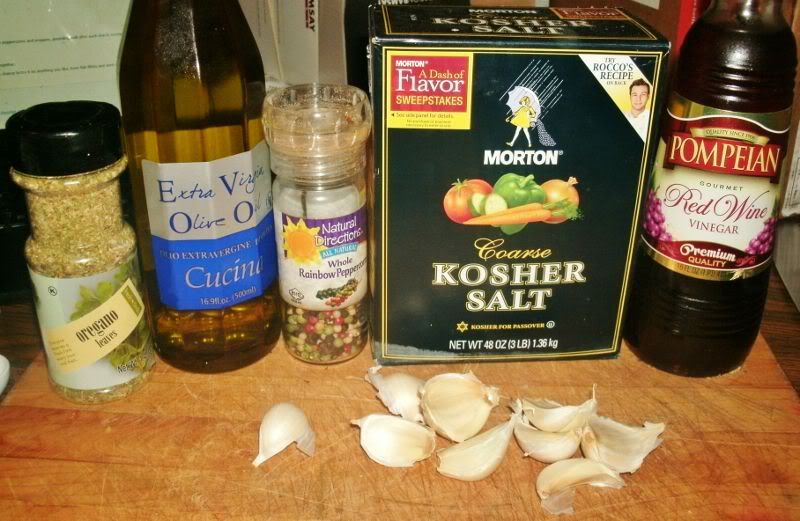
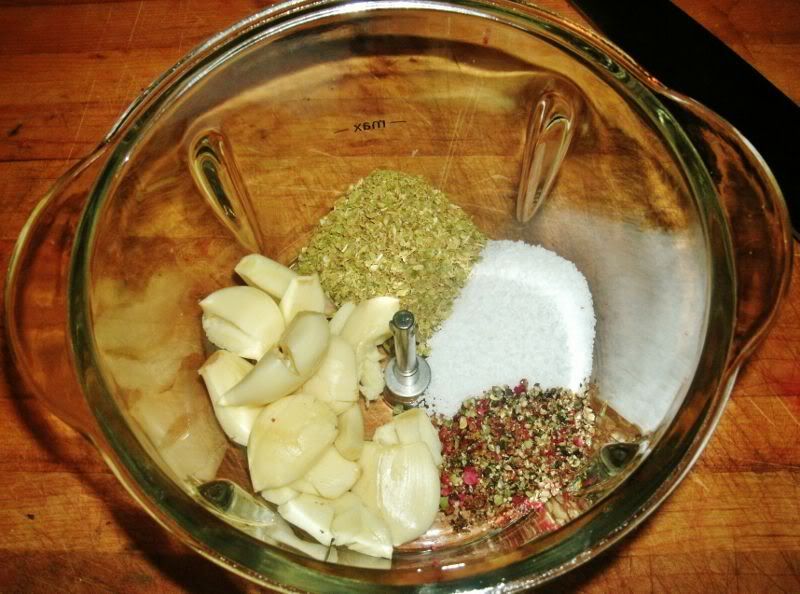
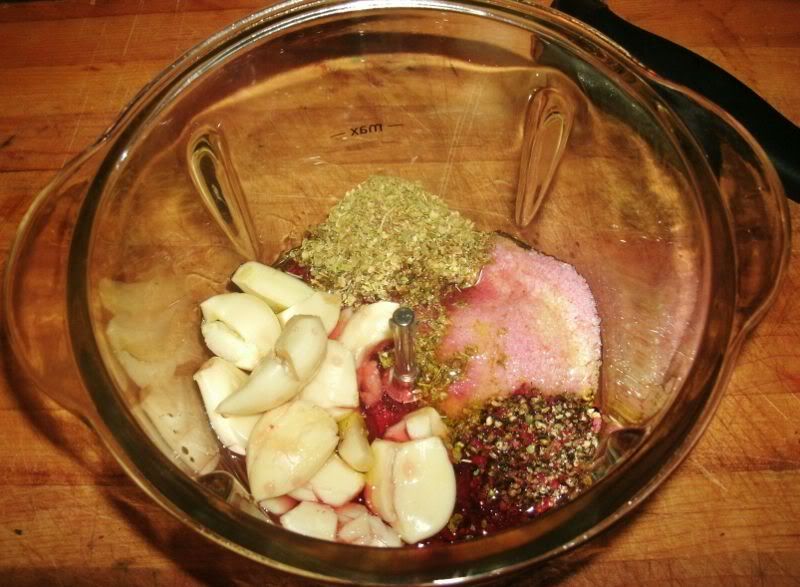
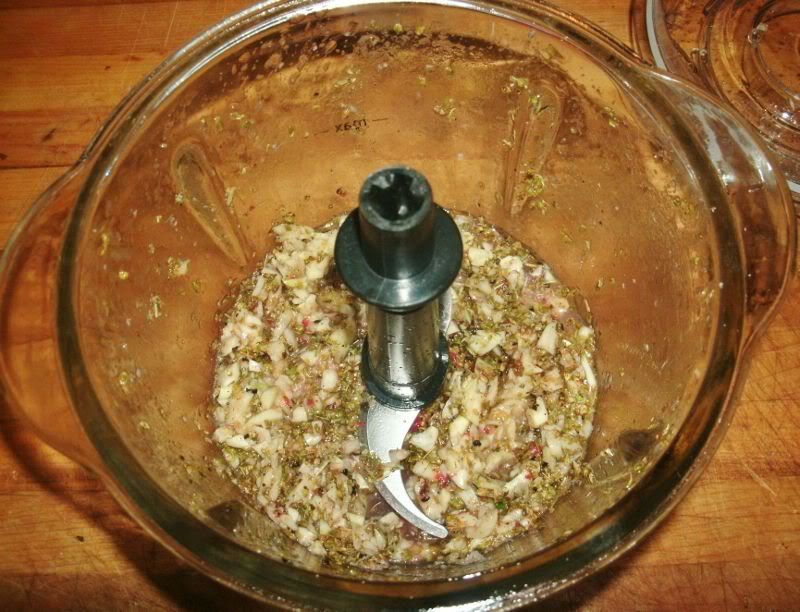

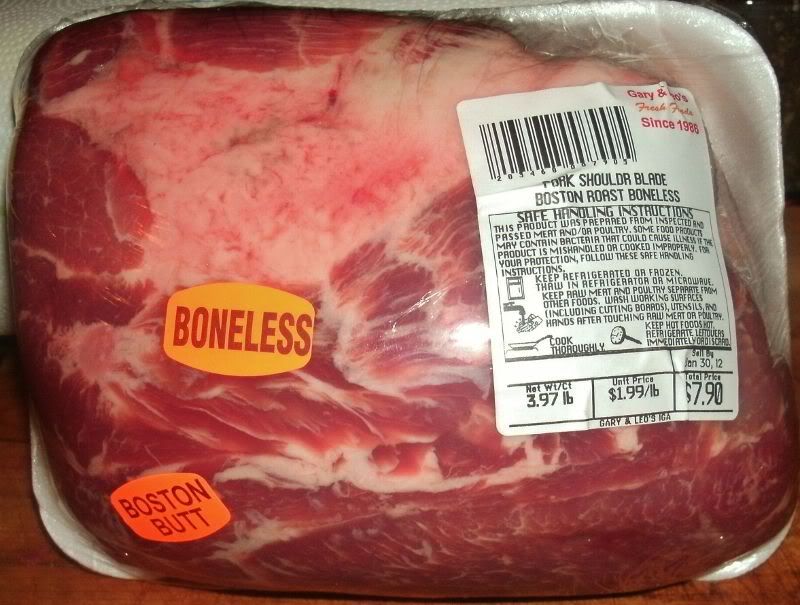
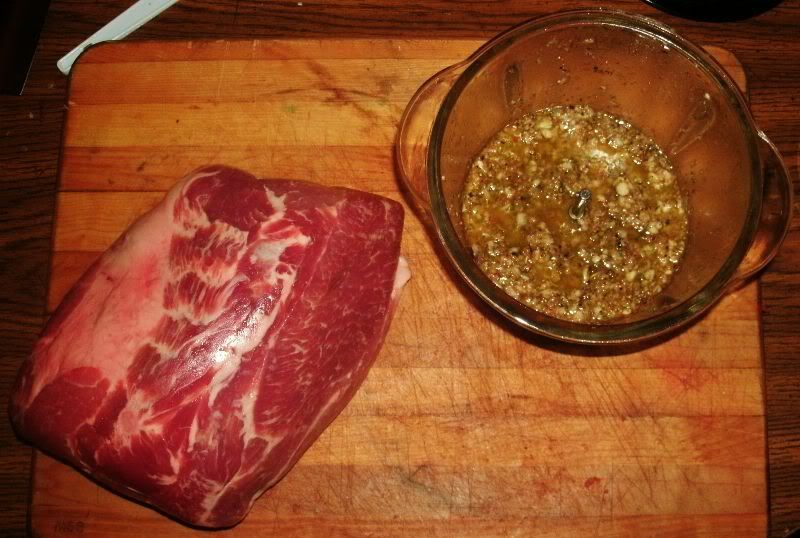
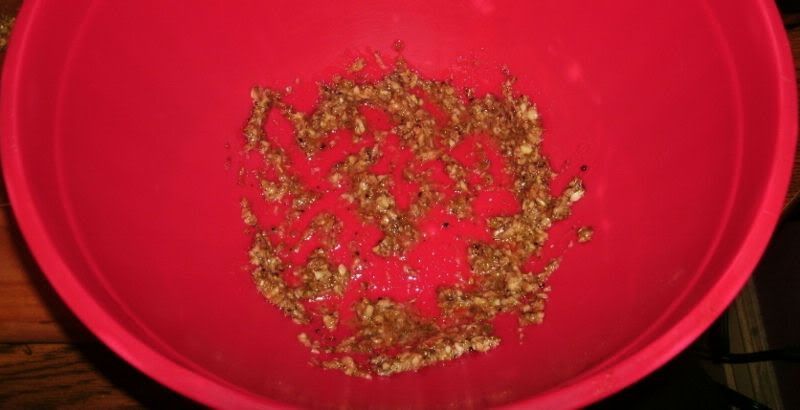
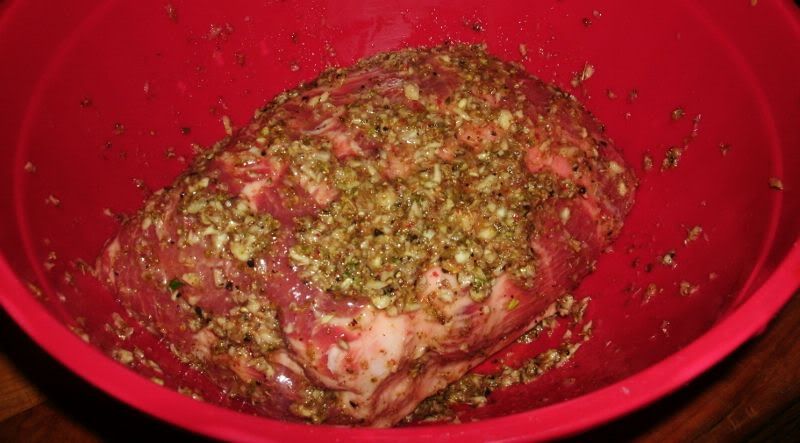


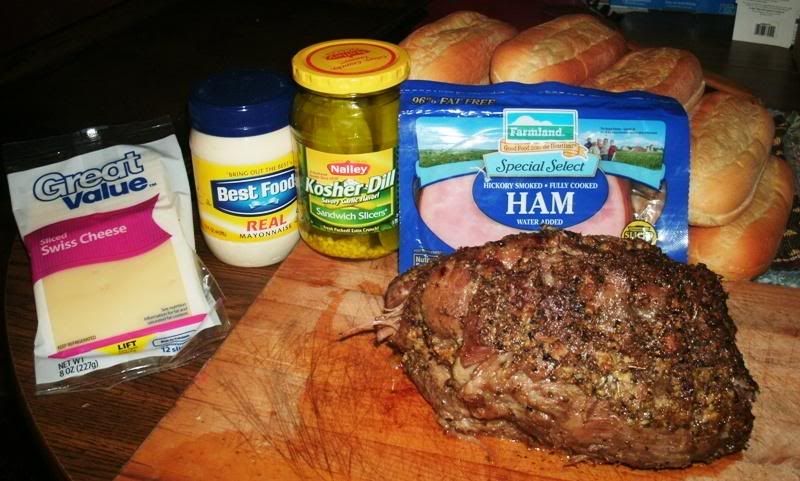
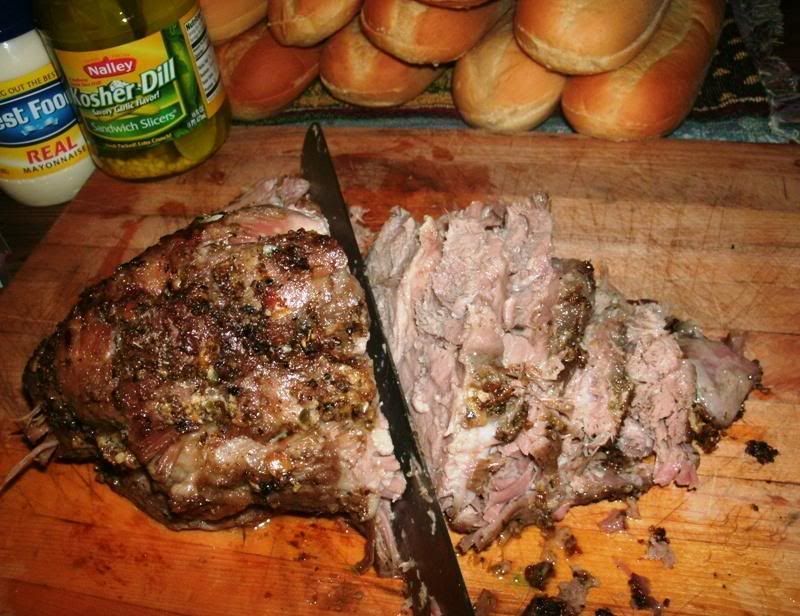

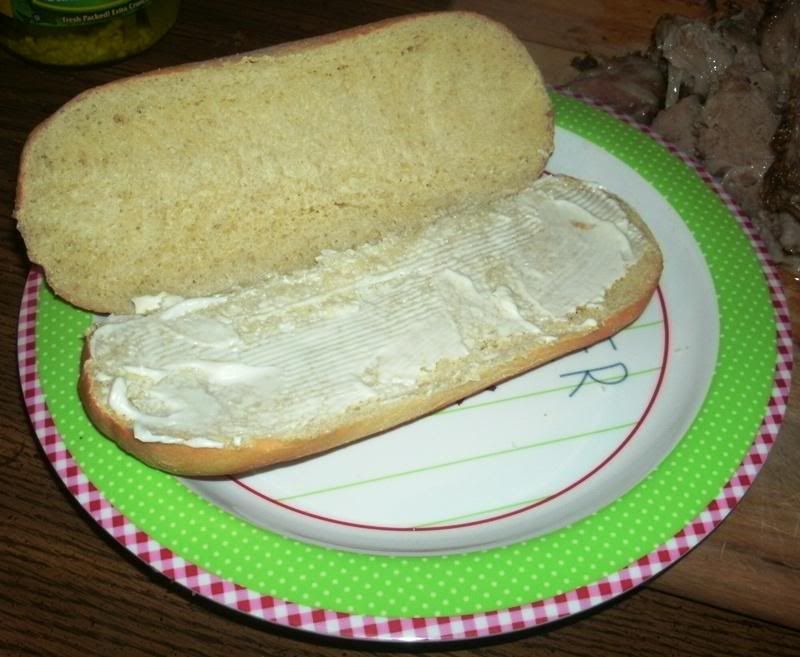
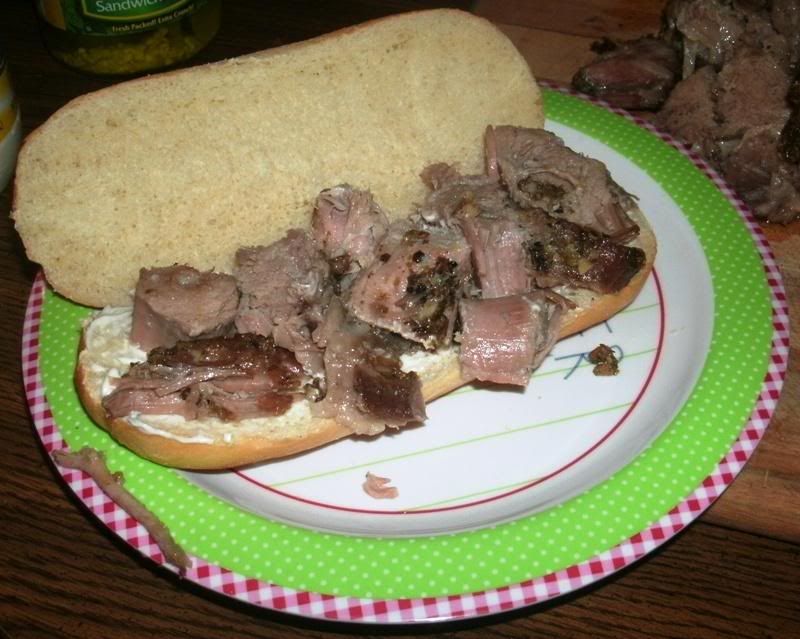
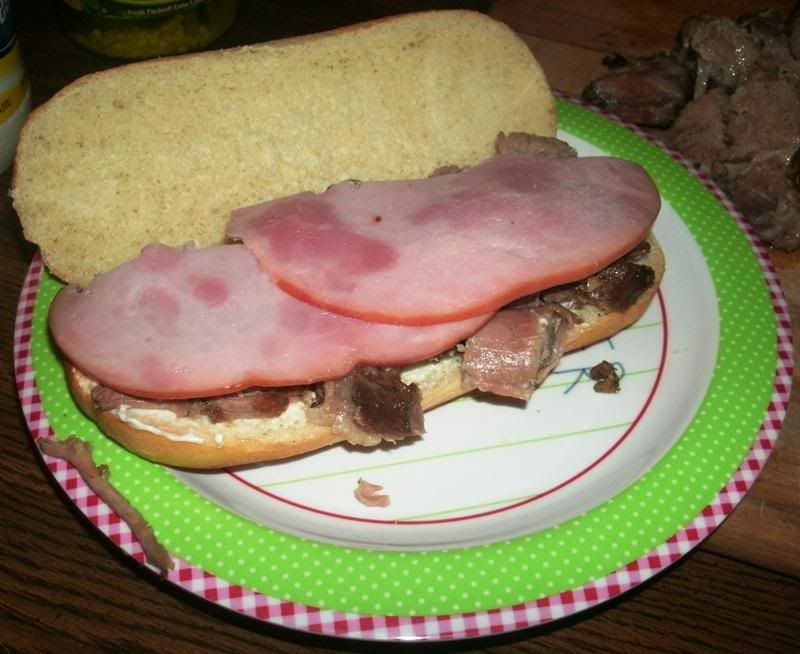


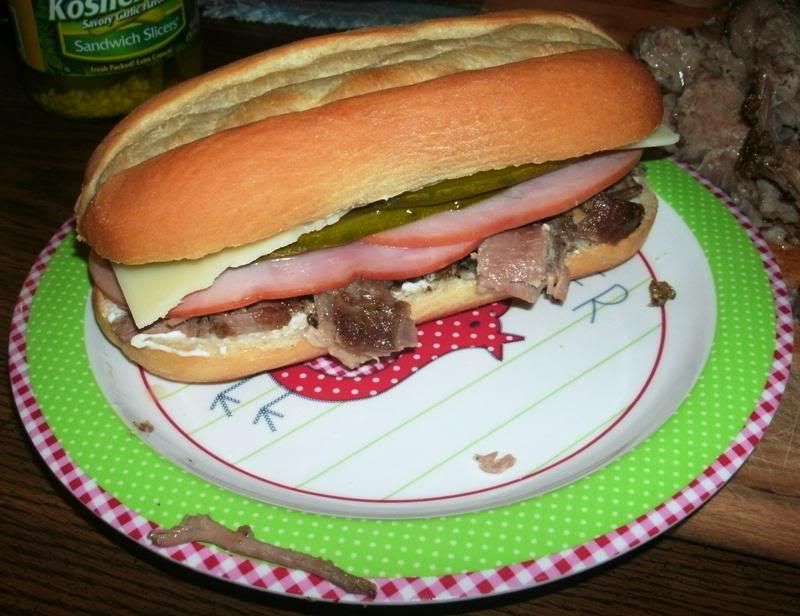
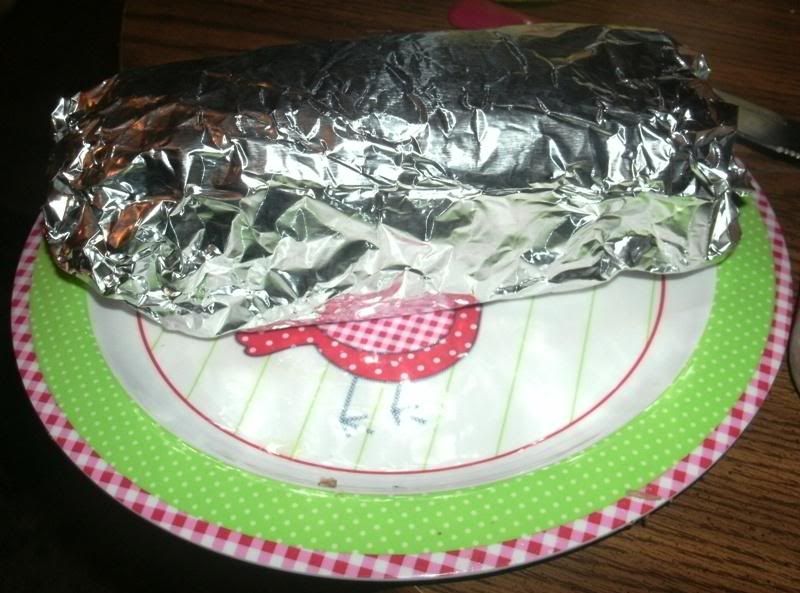

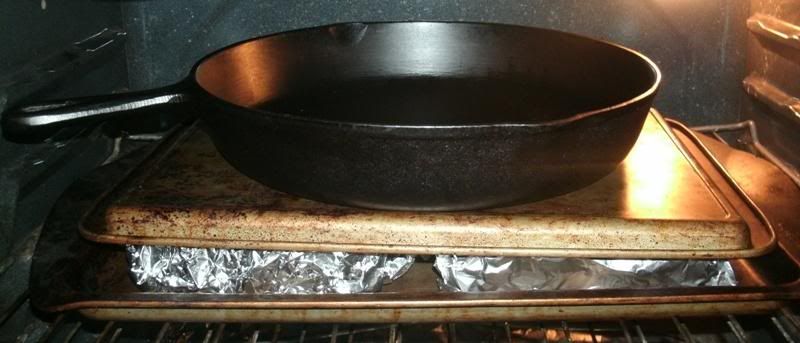
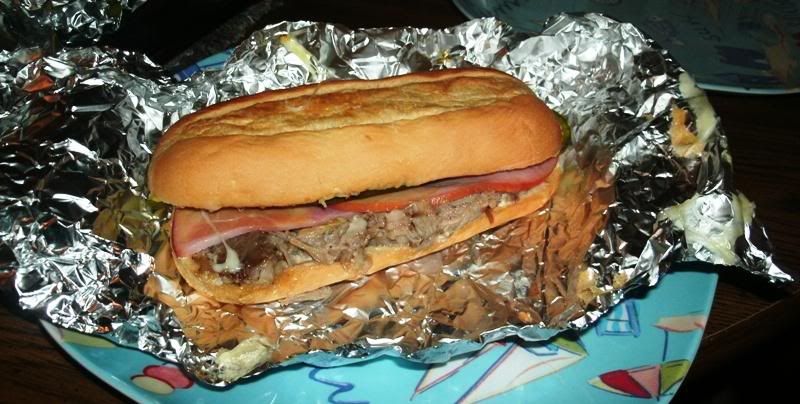
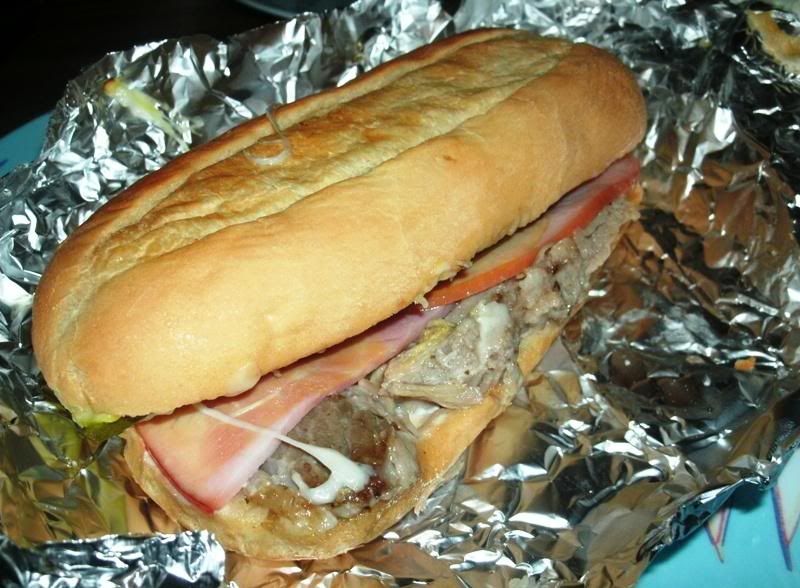


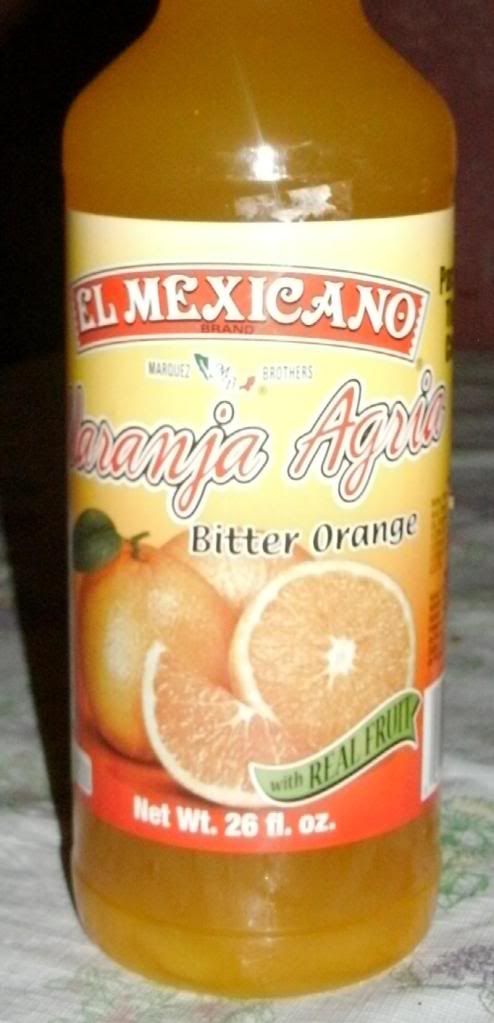
Comment